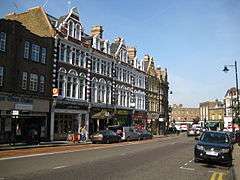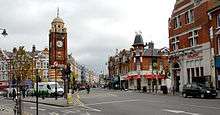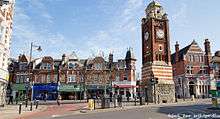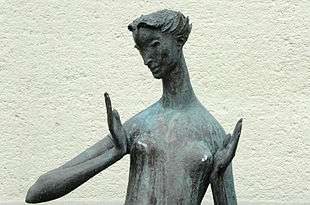Crouch End
| Crouch End | |
 |
|
 Crouch End |
|
| Population | 12,395 (2011 Census. Ward)[1] |
|---|---|
| OS grid reference | TQ295885 |
| London borough | Haringey |
| Ceremonial county | Greater London |
| Region | London |
| Country | England |
| Sovereign state | United Kingdom |
| Post town | LONDON |
| Postcode district | N8 |
| Dialling code | 020 |
| Police | Metropolitan |
| Fire | London |
| Ambulance | London |
| EU Parliament | London |
| UK Parliament | Hornsey & Wood Green |
| London Assembly | Enfield and Haringey |
Coordinates: 51°34′47″N 0°07′25″W / 51.579712°N 0.123729°W
Crouch End is an area of north London, in the London Borough of Haringey.
Location
Crouch End is in a valley between Harringay to the east; Hornsey, Muswell Hill and Wood Green to the north; Finsbury Park and Archway to the south; and Highgate to the west. Crouch End is located 4.6 miles north of Charing Cross and 5.1 miles from the City of London.
To the immediate west, it is bounded by Highgate Wood, and the adjacent Queen's Wood, as well as a large expanse of playing fields. To the north is Alexandra Park and to the south Finsbury Park. The Parkland Walk, a former railway line, connects these two parks. Other parks in the area include Stationers' Park, Priory Park and Crouch Hill Park.
Nearest places
History

Crouch End grew up as a hamlet on the old medieval route from London to the north. At this time it was governed as part of Hornsey, which became a parish in around 1300. The name "Cruch End" is recorded in 1593.[2] This heavily wooded area contained farms and country houses, one of which was Crouch Hall, probably built in 1681 at the crossroads of Crouch End. The transcribed 1829–1848 diaries of William Copeland Astbury, recently made available, describe in great detail London life of the period, including walks to Crouch End.[3] Crouch End remained rural until around 1880. Large parts remained in private ownership, inhibiting development. However, the development of the railway changed the area significantly. By 1887 there were seven railway stations in the area. Crouch End became a prosperous middle-class suburb due to an influx of mainly clerical workers who could easily commute to the city. The large old houses were replaced by comfortable middle-class housing, public parks were created, and a number of new roads and avenues, such as Elder Avenue and Weston Park, were laid out.
It expanded greatly in the late Victorian period and most of its present-day streets were built up in the late 19th century.
By the mid-1930s Crouch End had a popular shopping centre that included a Music Hall in the middle of Topsfield Parade.
Until 1965 it was administratively part of the Municipal Borough of Hornsey and that body's forerunners. In 1965, when local government in London was reorganised, Hornsey merged with the boroughs of Wood Green and Tottenham, and Crouch End became part of the London Borough of Haringey.

In the post-war years, the London-wide provision of social housing led to the building of council homes in and around Crouch End, Hornsey Vale and Hornsey itself. Many of the older houses in the area lay empty post-war and many were bought cheaply by speculative landlords who then let them out to the growing student populations of the Mountview and Hornsey Art College as well as to artists and musicians, who flocked to the area because of cheap rents. The area became known as student bedsit land for several decades into the early '80s until gentrification of the area changed the social profile and it became progressively more middle class. These social changes were illustrated by the changes in the shop types over the period; gentrification brought estate agents en masse along with up-market establishments and pavement-type cafes.
Notable buildings

Among its more prominent buildings is the modernistic Hornsey Town Hall, built by the Municipal Borough of Hornsey as their seat of government in 1933–35. The architect was the New Zealand-born Reginald Uren. The interior and exterior have been used several times as a location by the BBC soap EastEnders.[4] At the time of writing (September 2015) the London Borough of Haringey is preparing to offer Hornsey Town Hall for disposal via the OJEU process [5]
The centre of Crouch End is dominated by a red-brick clock-tower, built as a memorial to Henry Reader Williams[6] in 1895.
Education
For further details of education in Crouch End see the London Borough of Haringey article
There are three state secondary schools serving the N8 Crouch End area. Highgate Wood School in Montenotte Road is a nine form entry mixed school with Performing Arts Status reflecting the area's long association with the performing arts. Highgate Wood School was the senior school to the former Crouch End School based on the corner of Wolseley Road and Park Road, opposite the Maynard Arms. Hornsey School for Girls in Inderwick Road is the only single sex school in N8. In Hornsey, there is the Greig City Academy (formerly St David and St Katherines). Further away Heartlands High School which lies between Wood Green and Alexandra Palace was opened by Haringey in 2010; despite not being in Crouch End it is close enough to provide additional provision. Over 6,000 children school in the area, approx 2,300 in primary schools and 3,700 in secondary schools (11-18).
Kestrel House is an independent special school for pupils with autistic spectrum conditions and additional learning and behavioural needs. The vast majority of pupils are referred by local authorities in London and the Home Counties who pay the fees. It is housed in the former Mountview Theatre School premises at the north end of Crouch Hill -the end nearest Crouch End Broadway. Also in the independent (fee paying sector) are Highgate School and Channing School, both used by parents in Crouch End but located in Highgate.
There are a number of primary schools serving Crouch End (seven in total within the N8 postcode):Weston Park, on Denton Road next to Stationers Park and Hornsey Vale Community Centre, Rokesly School, Coleridge Primary School at the top of Crouch End Hill near the border with Islington, St Aidans in Stroud Green (not N8), St Gildas and St Peter-in Chains, just off Crouch Hill and St Mary's in Hornsey. Campsbourne Primary School on Nightingale Lane, North Harringay Primary School on Falkland Road and Ashmount Primary School. Ashmount was until December 2012 on the south side of Hornsey Lane, in Islington and in the N19 postal district, but only meters from Haringey. (The border between Haringey and Islington runs down Hornsey Lane.) The school moved January 2013 to a new building in Crouch Hill Park adjacent to the Parkland Walk in N8. The new site while closer to Crouch End is both still within Islington and further from the border with Haringey than the old site on Hornsey lane. There is a continuing (August 2014) public controversy regarding the ultimate fate of the old Ashmount site; more information about this is available under the entry for Ashmount Primary School
Library Provision
The public library for Crouch End is Hornsey Library located off Haringey Park N8. The library building is on a site adjoining the south side of Hornsey Town Hall. The Library contains a large book stock, DVDs, provides free access to the Internet, meeting rooms for adult education classes, a gallery for exhibitions. There is a separate children's library, where events for pre school children take place, with a public noticeboard with much information about local resources for parents of young children. There is also a cafe.

Local arts scene
Music
A recording studio called KONK was established on Tottenham Lane in nearby Hornsey by Ray Davies, the Muswell Hill-born leader of The Kinks. Later, in 1990s Dave Stewart of the Eurythmics set up a recording studio in the old church on Crouch Hill called The Church. In the early 1980s The Church was owned by Bob Bura and John John Hardwick, the animators who worked on Camberwick Green, Captain Pugwash and Trumpton, who had converted part of it as a studio and later rented space to Dave Stewart and Annie Lennox.
Today Crouch End is home to Crouch End Festival Chorus, a leading symphonic chorus which has recorded with Lesley Garrett, Bryn Terfel, Ray Davies, Alfie Boe, EMI Classics and Classic FM as well as singing on the soundtrack for Doctor Who. They perform four concerts a year and also undertake other professional engagements for concerts and recordings.
Creativity
In 2011, the 'Crouch End Creatives' community group was established and it now has over 2000 members. The group launched the 'Crouch End Festival' in May 2012,[7] which now features over 200 local performers/artists and involves over 80 venues, over 10 days in June. The next dates are Fri 5 - Sun 14 June 2015. Besides art exhibitions, drama, dance, film, poetry, photography and music, it features a number of novel events such as 'Poets in a Phone Box', 'Invented Histories', 'Art Creates Art Creates Art' and an outdoor cinema in the Town Hall square. In 2014 it held one of London's biggest Zombie Walks, with over 250 people, of all ages, dressing up to view Shaun of the Dead, which was shot in Crouch End. In 2013 it teamed up with nine local schools to encourage creativity in young people. The Festival group also runs a Christmas market, Shop Local campaigns, and works with schools to connect students with artists.
Hornsey Town Hall For a long while, the former Hornsey Town Hall was destined to be the new home of Mountview Academy of Theatre Arts subject to planning permission but Mountview (23 January 2015) announced that it was no longer planning to relocate to the site leaving the future of HTH with uncertainty. Previously the Town Hall has been used as a film location for TV programmes such as The Hour and Whitechapel and films including Two Down. It was used in 2014 (20 March to 25 May) as a venue for a Surprise Cinema showing of the Coen Brothers classic gangster movie Miller's Crossing. At the end of 2014 the council granted use of the Town Hall to ANA (for 14 months) to develop it as a cultural arts centre renaming it the Hornsey Town Hall Arts Centre.
Hornsey Art School
In 1880 an Art School was established which, in May 1968, as Hornsey College of Art, was the centre of a protest against the ideology of the school's teaching methods. The college was merged with what was then Middlesex Polytechnic, now University, in the 1970s. Subsequently it was relocated to a Middlesex campus at Cat Hill and the lease of the building taken over by the TUC, which used it as its national training centre. In 2005, the TUC surrendered the lease and Haringey Council took it over, extending and converting the building in order to enlarge Coleridge Primary School.
Arts scene urban legends
- According to legend, in the 1990s Dave Stewart of the Eurythmics invited Bob Dylan to drop into his Crouch Hill recording studio any time he wanted to. It is said that Dylan took him up on his offer, but the taxi driver dropped him off on the adjacent Crouch End Hill. Dylan knocked on the door of the supposed home of Dave Stewart and asked for "Dave". By coincidence, the plumber who lived there was also called Dave. He was told that Dave was out, and would he like to wait and have some tea? Twenty minutes later the plumber returned and asked his wife whether there were any messages. "No," she said, "but Bob Dylan's in the living room having a cup of coffee".[8]
- Stephen King and his wife, Tabitha, were invited to dinner by his friend, Peter Straub, whose house is in Crouch End.[9] En route to Straub's house, the Kings got lost, like the American couple in his story, and ended up by the old railway line, now called the Parkland Walk. The strange unsettling surroundings inspired King, as did the sculpture of a spriggan (a pan-like green man), which was pushing its way out of an old arched wall. King wrote the short story "Crouch End" based on his visit, which was later adapted as an episode of Nightmares and Dreamscapes: From the Stories of Stephen King, which included the spriggan in the introduction.[10]
- It is claimed that Stan Laurel and Oliver Hardy once performed at the music hall that is now Virgin Gym and that they stayed at the Queen's Hotel (now the Queen's pub). Artist Richard Hamilton is said to have taken visitor Marcel Duchamp to the Queen’s Pub. The pub was built as a hotel in 1899–1902 by developer and architect John Cathles Hill to serve visitors to the Alexandra Palace races. The bar is an excellent example of a Victorian pub and also features a fine example of Art Nouveau style glass.
- Jean Simmons was born on 31 January 1929 in Crouch End.[11]
Location for literature, film and television
Crouch End has been used as a location for film, TV and literature. Examples include:
|
Literature
|
Film
|
Television (mainly using Hornsey Town Hall)
|
Notable residents
- See Category:People from Crouch End
Transport
Nearest tube stations
Nearest railway stations
Bus services
See also
- Hornsey (parish) for the ecclesiastical and local government unit of which Crouch End was part from medieval times to 1867
- Municipal Borough of Hornsey for the local government unit of which Crouch End was part from 1903–1965
References
- ↑ "Haringey Ward population 2011". Neighbourhood Statistics. Office for National Statistics. Retrieved 22 October 2015.
- ↑ "John Norden's map of Middlesex". Jonathan Potter Ltd. Retrieved June 2015. Check date values in:
|access-date=(help) - ↑ "William Copeland Astbury". Facebook. Retrieved 2013-11-07.
- ↑ "Haringey on Film - document from Haringey Council". Retrieved 17 February 2012.
- ↑ http://www.hornsey-town-hall.org.uk/pages/news/index.asp?NewsID=100
- ↑ Henry Williams was a local wine-merchant and local councillor who led the campaign to preserve Highgate Wood against threatened development.
- ↑ "Creative Festival of over 160 events". Crouch End Festival. 2013-09-15. Retrieved 2013-11-07.
- ↑ "expectingrain.com". expectingrain.com. 1997-06-08. Retrieved 2013-11-07.
- ↑ "An Interview with Peter Straub (March, 2010) | Bookbanter". Bookbanter.wordpress.com. Retrieved 2013-11-07.
- ↑ Beahm, George (1 September 1998). Stephen King from A to Z: An Encyclopedia of His Life and Work. Andrews McMeel Publishing. p. 47. ISBN 0836269144.
- ↑ "Jean Simmons". IMDb. Retrieved 15 April 2015.
- ↑ "The North London Book of the Dead". F2.org. Retrieved 2013-11-07.
- ↑ "The Loop". IMDb.com. Retrieved 2013-11-07.
- ↑ "BBC Four - Breaking the Mould: The Story of Penicillin". Bbc.co.uk. 2011-04-19. Retrieved 2013-11-07.
External links
- Local community website for all of N8
- Local community website used by Crouch Enders
- Hornsey Historical Society
- Crouch End Cricket Club
- Crouch End Business directory
- Photos tagged with "CrouchEnd" at Flickr
- Crouch End Project - local shops listing
- Facebook group - Crouch End Creatives
- A True History of Crouch End
- Crouch End Open Studios Annual event promoting local artists
- Hornsey Town Hall Appreciation Society Action Group concerned for the future of Hornsey Town Hall
